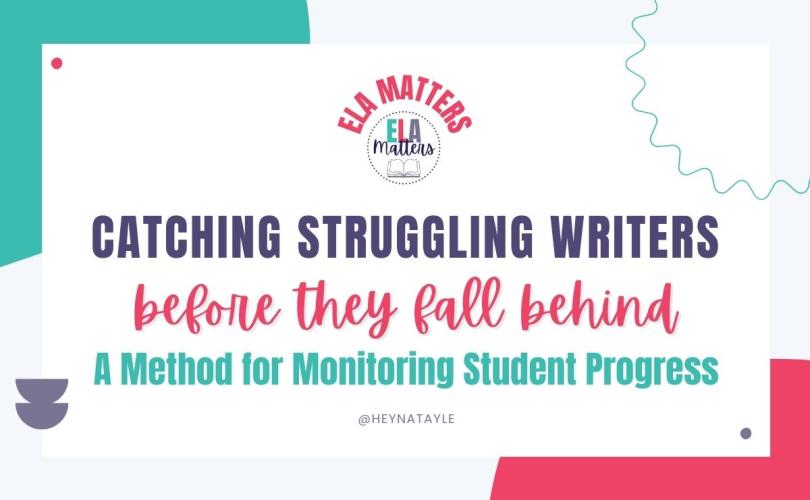Ask any ELA teacher what their least favorite part of the job is, and they’ll likely say something about grading. I don’t disagree. Spending countless nights and weekends with a stack of papers is more painful than non-ELA teachers could imagine. But what’s icing on the cake is thinking you’ve reached the end of your stack only to realize how many missing submissions you still have.
Ugh. Another future night to be spent grading papers you’d like nothing more than to be done with. Not to mention that the students who have yet to submit anything likely need serious help that now has to be done outside of class time because you’re starting a new unit. Double ugh.
If these frustrations sound all too familiar, I’ve got news for you.
It doesn’t have to be like this. There is a better way.
What if I told you you could implement a checkpoint system at the beginning of your writing unit to ensure each student got timely help before they fell behind?
It’s true. Today, I will show you how I combined my single-point writing rubric with a check-in system to guide and support my students through our writing unit most transparently and succinctly possible.
If it sounds like a lot, it’s not.
Let me take you through what this looks like in my classroom.
Outlining the Unit
Beginning with the end in mind is always wise. I identify what I want students to be able to do by the end of the writing unit and what their final product might look like.
Then, I create a single-point rubric based on those priorities. Because it is a single-point rubric, I only fill in the column of what this looks like for students who meet expectations.
For my informational text unit, the rubric boils down to 5 major categories:
- Controlling Idea
- Development
- Organization
- Language
- Conventions
Specifically, students should be able to:
- Present a clear central idea/topic and maintain it throughout their writing.
- Accurately explain their ideas and findings and show how they support the central idea.
- Organize their information in a logical structure that develops their central idea.
- Use transitions to clarify relationships between their ideas and information.
- Write in a formal style using a formal tone.
- Use precise language that is specific to their topic.
- Use correct capitalization, usage, punctuation, and spelling.
Once I look at the single-point rubric, I can see that my mini-lessons will need to meet those needs through five different phases:
- Prewriting
- Drafting
- Revising
- Editing
- Publishing
Then, the checkpoint system comes into play.
Creating a Checkpoint System
Once I see my unit coming together, I implement “checkpoints” for students. On the first day of the unit, after we discuss what students will be working on and look at examples, we get into the nitty-gritty.
I share with students the different phases of the unit (see above), and we talk about the deadlines for each phase. Together, the students and I go through our single-point rubric and add in the checkpoint dates.
Then, each time we have a checkpoint, students turn in their rubric/checkpoint sheet, and I quickly scan their progress (usually the Google Doc). I don’t go through their drafts and provide specific feedback (that’s what individual conferences during writer’s workshop are for); I simply take stock of each student’s progress, whether it’s their outline, draft, or final revision.
I spend less than 30 seconds per student reviewing progress and awarding points. Meeting the checkpoint deadlines accounts for 2 points each time, or in this case, 30% of their final points (in the grade book, it’s two separate grades: Work Habits grade and a Writing grade, but they don’t know that!). This serves a few purposes:
- If a checkpoint goes in the grading system as Missing or Incomplete, the student (and often their parents) is alerted,
- It alerts me to prioritize checking in with this student before my regularly scheduled writing conferences,
- It increases the likelihood that the student gets back on track.
Then, I pass back their checkpoint sheet at the start of the next period so they can keep their rubric front and center as they work.
Making it Work For You
If this sounds like a system that will help you catch struggling writers before they fall behind, you can make a copy of my rubric here. Change it to fit your needs, whether you are teaching informational writing, argumentative writing, narratives, or anything else. Here are a few tips:
- Keep it short and simple. Only focus on what you want your students to do.
- Leave space for feedback.
- Consider adding your deadlines as you go if you aren’t sure how long your students will need in each phase of the writing unit.
- Set aside time to intentionally check student progress (otherwise the deadlines are useless).
- Include any resources that might help your students on the back side. Whether it’s a word bank of transitions, reminders about formal tones, CUPS, ARMS, or something else.

